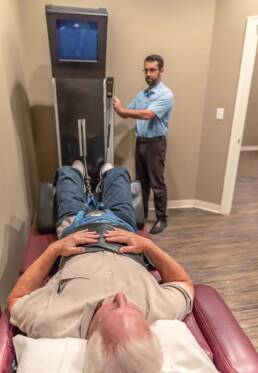Most people seek chiropractic care because of some pain they’re experiencing. They’re looking for solutions that aren’t dependent on harsh pain medications or surgical intervention.
As you seek chiropractic care, understand that not all chiropractors offer the same level of knowledge or techniques. Discover the difference between traditional chiropractic and structural chiropractic care and the benefits of visiting a qualified structural chiropractor.
Different Chiropractic Approaches
Let’s begin by looking at the difference between traditional and structural chiropractic care approaches. Traditional chiropractic techniques are what every chiropractor receives when completing their Doctor of Chiropractic Medicine program. The primary goals of traditional care include temporary pain relief, reducing muscle spasms, and increasing the range of motion.
These are important, being this is why most people seek out chiropractic care in the first place. However, this approach often lacks getting to the underlying causes of the pain. Without tackling this root cause, your pain may never fully resolve.
Structural chiropractors take a little different approach. What we’ve found through education and experience is that most of the symptoms that cause people to seek chiropractic care relate to some shift in the body’s underlying structure. This doesn’t stop with the spine and joints but can also include ligaments, muscles, tendons, discs, and nerves.
By dealing with the structural shifts, you resolve the problem that’s causing the high-level symptoms. Even with a different focus, structural chiropractic patients still experience pain relief that comes from traditional chiropractic techniques.
Understanding Structural Shifts
Before jumping into why you should visit a structural chiropractor, it’s important to understand structural shifts. The best way to wrap your mind around this is by considering how a suspension bridge works. There are a lot of parts to the bridge that keep it straight and allow it to complete its function. This includes not only the road and the structures that hold the road in place, but also the supports, the suspension cables, and the concrete anchors at either end.
Your body isn’t all that different in how it works. You have the core foundation that holds everything up, which is your spine and skeletal structure. This is like the road in the suspension bridge analogy.
Just like the bridge has suspension cables to hold it in place, you have a plethora of support structures. These are your muscles, tendons, and ligaments. If one or more support cable on a suspension bridge is too short, it’d completely distort the shape of the bridge. Likewise, when one or more of our support structures is too tight, it pulls on many other parts, twisting the overall structure.
5 Benefits of Structural Chiropractic Care
As you can imagine, when part of your underlying structure isn’t in its proper place it will cause signals that something isn’t right. Here are five reasons you should add structural chiropractic care to both your injury recovery and your general wellness plan.
1. Improved Nervous System Communication
Where the bridge analogy breaks down is in the complexity of how the human body works. Not only is it a structure that’s intricately held together, but that structure constantly sends communication signals within itself.
The communication pathways in the body are more like rivers that continue to flow until there’s something restricting it. That restriction either blocks the flow altogether, slows it down, or forces it through a different path. The same thing happens when something interrupts your nervous system’s communication pathways, such as with structural shifts.
By identifying the underlying structural shifts and working to correct them, you improve the pathways through which your body passes communications. Beyond overall health, this also helps control inflammation and nutrient flow throughout the body, including to damaged or injured tissues.
2. Better Joint Mobility
Joint mobility simply refers to the degree that a joint can move before experiencing restriction from the surrounding tissue. Common causes of reduced joint mobility include inflammation around the joint, mechanical problems within the joint, overall tightness of the surrounding muscles, pain, and some diseases.
Structural chiropractic care looks at both the joints themselves, but also the surrounding and supportive tissues. Many joint mobility problems stem from the supporting tissues like muscles and tendons becoming too tight, pulling the joint in unusual ways.
Your chiropractor’s treatment plan will work to release the tightness in those supporting tissues and then adjust the joint to bring it back into its proper place and orientation. Some of their techniques and recommendations for home exercises will help keep your joints properly placed and your supporting tissues appropriately loose.
3. Better Muscle Control
Muscle control may make you think of the commercials where a bulked man flexes various muscles independently. This is a great example of muscle control, but it is also important for how you move through your day and how you complete regular tasks.
Structural shifts can also change how the brain interprets the physical stimuli your body receives. These can include things from your external world, but also relates to how your body is moving and which muscles are activating. When your brain isn’t registering signals from your muscles correctly, it inhibits your ability to control them.
Part of the major focus of structural chiropractic care is ensuring the information pathways are clear so that the brain can send and receive the right signals. Further, one 2020 study found that structural chiropractic manipulation also produced an increase in muscle strength.
4. Strengthened Ligaments
A ligament is the fibrous connective tissue that binds bones together. Ligaments are a major component of joint injury, with weak ligaments causing hypermobility that can cause pain and discomfort, not to mention joint deterioration.
Structural chiropractors take more time to thoroughly evaluate your movement issues. In that evaluation, they can identify weak ligaments that are degrading structural integrity. Structural chiropractic treatment corrects subluxations that cause weakened ligaments. They’ll also recommend exercises to continue the strengthening work at home.
5. Secondary Condition Recovery
Secondary symptoms are the symptoms that commonly bring people to seek the services of a structural chiropractor. By solving the underlying structural shift, you also solve the secondary conditions. These could include:
- Pain
- Numbness
- Tingling
- Muscular spasms
- Dizziness and balance issues
- Degenerative discs
- Degenerative joints
- Poor posture
- Muscular imbalance
- Wrist pain
- Shoulder pain
- Disc injuries
Call (936) 756-3747 to schedule your complimentary consultation with one of the structural chiropractors at Freedom Chiropractic to see if our approach is a good fit to help you resolve your chronic pain issues.

Ready for a complimentary consultation? Get in touch today!
Much like an engineer, we focus on setting up your body to do the activities that you want to do most. An engineer would make sure a bridge could accommodate Houston traffic, and we will make sure your body can accommodate your favorite sport, family activity, or your next adventure.
Like this article? Spread the word!
Related Posts
March 10, 2024
Unlocking Wellness: The Power of Structural Chiropractic Care at Freedom Chiropractic in Conroe, TX
Unlock your body's full potential with structural chiropractic care at Freedom…
March 28, 2023
The Reasons Why People Love Visiting Chiropractors
In our busy lives, we often have to face challenges related to maintaining our physical…
February 28, 2023
The Benefits of Chiropractic Care Might Surprise You
At Freedom Chiropractic in Conroe, Texas, we specialize in treating back pain, muscle…



